There’s very little room for error, and this is even truer in an economic downturn when customers are more cautious with their spending.
Having a customer-driven, solution-focused approach to CX design is critical to delivering the experiences customers want — not the ones you think they want.
Marketing and CX experts need to be aligned on what both see as the common customer problems, customer bright spots and the priorities to reinforce and fix those areas to best work together to incorporate design thinking.
Boosting CX Agility With Design Thinking
“The secret to increasing engagement and reducing dropoff is pretty simple: understanding what customers are trying to do, and how they want to go about it,” explained Niki Hall, CMO of Contentsquare.
She said the benefit of the design thinking approach is that is has a built-in strategy to test, troubleshoot and improve — key attributes of CX agility, which has proven critical in the face of shifting consumer trends.
The short form of the design thinking process can be articulated in five steps or phases: empathize, define, ideate, prototype and test.
“The whole design thinking methodology is underpinned by empathy — in other words, the ability to put yourself in someone else’s shoes,” Hall said.
When it comes to building standout experiences that can adapt to shifting consumer priorities, having that ability to understand customers in real time and to surface friction and bottlenecks along the customer journey is key.
“That’s the beauty of customer experience data — with a holistic understanding of why customers behave the way they do, CX teams are equipped to experiment, iterate and improve,” she noted.
Design Thinking Offers Consistent Approach
Chad Storlie, senior director and analyst at Gartner, explained there are two primary reasons why design thinking is important for CX.
“First, design thinking is built around the customer and CX improvements all revolve around determining and delivering to the customer needs along the customer journey,” he said. “Second, design thinking is a consistent approach for observing, understanding and delivering to customer needs.”
He said this consistent approach fits very well with other customer experience tools such as personas, journey maps and customer experience scorecards.
“Design thinking is not a ‘giant killer’ for instant customer experience success,” he cautioned. “It is a rigorous research and development process that must be fully adhered to, so customer needs are clearly understood, developed, tested and delivered for customer success.”
Customer Needs Must Be the Focus
Just like in customer experience, the success of design thinking is built within the clear and precise understanding of what the customer needs to be successful at the design point or at the customer journey stage, which is usually encapsulated within the empathize and define steps.
Storlie said these are the critically essential elements because if you do not fully understand what the customer needs, then all the following steps in the design thinking process will be flawed because you did not fully understand what the customer needed to be successful.
“For example, if I am building a mobile application targeted at rural farmers, I have key considerations for the daily work of a farmer,” he said. ”If I don’t make the application UX easy to use when the farmers are wearing gloves or when they are in a low availability of Wi-Fi area, I am fundamentally misunderstanding my customer base in my design process.”
Therefore, the design thinking process should really emphasize customer observation, customer “go and see,” and customer interviews to make sure that they have identified the correct customer needs.
A Companywide Commitment to Design Thinking
From Hall’s perspective, design thinking is more than just a tactic; for it to be impactful, it needs to be an organizationwide mindset.
“When it comes to building outstanding customer experiences, customer understanding needs to be at the heart of all decision-making, and across the organization,” she explained.
Design thinking provides a framework and methodology to ensure impactful action, but it really boils down to having a human-driven, solution-focused, iterative process — something that can benefit any innovation and troubleshooting strategy.
Storlie said design thinking must focus on the consistent end-to-end execution of a process that will deliver for the customer.
“Design thinking will extend into internal teams that need to have their own internal redesign process to meet the customer needs that design thinking steps have revealed,” he noted.
With this understanding, design thinking stakeholders must include the internal functional teams that are directly and indirectly involved with delivering the improved process originating from the design thinking process.
He pointed out the inclusion of all direct and indirect internal stakeholders also significantly increases the likelihood of adoption because stakeholders are identified and included in the design thinking process from the beginning.
“The inclusion of internal stakeholders also makes the design thinking team more effective because the internal stakeholders can provide their expertise and historical experience to ensure an effective design thinking product,” Storlie said.
Building a Customer-Centric Future
Hall explained business success in the customer experience era hinges on understanding customers and being able to adapt as quickly as their priorities and preferences do.
“Consumers have never had more influence and agency over the digital experience, and this is only increasing,” she said. “A keen understanding of customers and the ability to drive intelligent and impactful action across the organization will be key to keeping up with the pace of digital transformation.”
Storlie added the real reason that customer experience and marketing professionals should be excited about the growing appreciation of design thinking is that it is another important step placing the customer at the centre of an organization.
“The transition from a product-centric approach to a customer-centric approach is a challenge for every organization,” Storlie explained. “The use of design thinking is another important tool that helps an organization understand, create options, test and deploy solutions that will make a real difference for customers.”



















